Nestled in the vast expanse of the South Pacific Ocean, Fiji beckons with its promise of idyllic beaches, vibrant coral reefs, and a rich cultural tapestry. This island nation, a mosaic of over 300 islands and islets, has long captivated travelers seeking an escape to paradise. But for those dreaming of Fijian shores, the first question often is: where exactly is Fiji located? Let’s embark on a geographical journey to pinpoint this South Pacific gem and discover what makes its location so unique.
Discovering Fiji’s Precise Location
Fiji is strategically positioned in the southwest Pacific Ocean, acting as a bridge between the major continents and other island nations. To put it in perspective, Fiji lies approximately 1,770 kilometers (1,100 miles) northeast of New Zealand and about 2,900 kilometers (1,800 miles) east of Australia. This places it firmly within the Melanesian region, a culturally rich and geographically diverse area of Oceania that also includes Papua New Guinea, Vanuatu, the Solomon Islands, and New Caledonia.
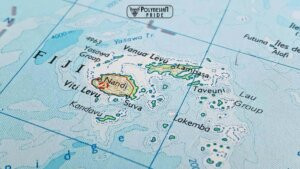 Fiji Island location on the map
Fiji Island location on the map
For those needing precise coordinates, Fiji is centered around 17.7134° South latitude and 178.0650° East longitude. While the total land area of Fiji is around 18,274 square kilometers (7,056 square miles), its islands are scattered across a much larger oceanic area. The majority of Fiji’s landmass is concentrated within its two principal islands: Viti Levu and Vanua Levu.
Fiji’s Geographical Landscape: An Archipelago Unveiled
To truly understand Fiji’s location, visualizing its geography is key. Imagine an archipelago stretching across almost 1.3 million square kilometers (500,000 square miles) of the South Pacific. This is Fiji’s aquatic domain. Within this vast ocean space lie 332 islands, though only approximately 110 are inhabited. This abundance of islands contributes to Fiji’s reputation as a secluded and diverse destination.
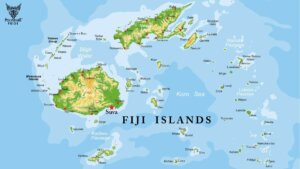 Geographical Map of Fiji Island
Geographical Map of Fiji Island
Looking closer at the two major islands, Viti Levu dominates with an area of 10,388 square kilometers (4,011 square miles). Vanua Levu, the second largest, covers a substantial 5,587 square kilometers (2,157 square miles). Viti Levu alone accounts for nearly 90% of Fiji’s total land area, making it the undisputed heart of the nation. Beyond these giants, islands like Taveuni, Kadavu, and the Yasawa and Mamanuca groups offer distinct landscapes and experiences, further enriching Fiji’s geographical tapestry.
Population Distribution in Fiji
As of July 1, 2024, Fiji is home to an estimated population of 943,067 people, according to United Nations data. This figure represents approximately 0.01% of the global population, placing Fiji 162nd in the list of countries by population size. While the total land area is 18,270 square kilometers (7,054 square miles), the population density is around 51 people per square kilometer (133 people per square mile).
Interestingly, Fiji is significantly urbanized, with about 59% of the population (around 552,523 people in 2023) residing in urban areas. The median age in Fiji is 27.2 years, indicating a relatively young and dynamic population. This demographic context adds another layer to understanding Fiji’s character, blending island tranquility with pockets of vibrant urban life.
Fiji’s Tropical Climate: A Year-Round Paradise
Fiji’s location firmly places it within a tropical climate zone, ensuring warm temperatures and high humidity throughout the year. The islands experience two primary seasons: a wet season from November to April and a drier season from May to October. Average temperatures typically range from a comfortable 26-31°C (79-88°F), solidifying Fiji’s appeal as a year-round destination for sun-seekers.
The wet season can bring cyclones and heavier rainfall, potentially affecting travel plans. However, this period also transforms the landscape into a lush green paradise, with waterfalls flowing powerfully, making it an attractive time for nature enthusiasts. The dry season offers sun-drenched days with minimal rain, making it the peak tourist season, perfect for beach holidays and water activities.
A Journey Through Fiji’s Culture and History
Long before European contact, Fiji was inhabited by indigenous tribes, the iTaukei, who thrived on the land and sea. These communities possessed rich traditions, expressed through elaborate ceremonies, captivating dances, and intricate art forms like tattooing and carving. They lived in communal societies, deeply connected by kinship, relying on fishing, agriculture, and trade for their livelihood.
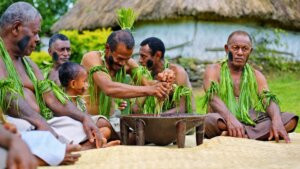 The Kava ceremony in a Fijian village. Image courtesy of Tourism Fiji
The Kava ceremony in a Fijian village. Image courtesy of Tourism Fiji
Indigenous Heritage and Cultural Practices
The iTaukei people, Fiji’s indigenous inhabitants, developed a vibrant culture characterized by elaborate rituals, traditional dances like the mesmerizing Meke, and artistic expressions such as detailed wood carvings and the symbolic Veiqia tattoos. While Christianity arrived in the 18th century, traditional beliefs and practices continue to coexist and thrive. Kava ceremonies, involving the sharing of a mildly intoxicating drink made from the kava root, remain a central social and cultural ritual, embodying Fijian hospitality and community spirit.
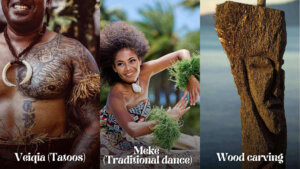 Fijian traditions
Fijian traditions
The British Colonial Era
The 19th century marked a turning point with the arrival of European settlers and the establishment of British colonial rule. This era brought significant changes to Fijian society, introducing new social, economic, and political systems that profoundly impacted the indigenous population. Colonial rule lasted until 1970, leading to developments such as sugarcane plantations and the introduction of indentured laborers from India, further shaping Fiji’s multicultural identity.
The Path to Independence
Fiji peacefully gained independence from British rule on October 10, 1970, becoming a sovereign nation. This marked the beginning of a new chapter, focused on building a multicultural society that honored its diverse heritage and paved its own path on the global stage.
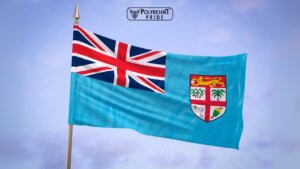 Fiji Celebrated Independence from British Rule in October 1970
Fiji Celebrated Independence from British Rule in October 1970
Celebrating Culture in Modern Fiji
Today, Fiji stands as a dynamic multicultural nation, proudly embracing its diverse history and celebrating its indigenous culture through numerous festivals, events, and enduring traditions. Key cultural events include the Hibiscus Festival in Suva, a vibrant celebration of Fijian culture with music, dance, and food; the Bula Festival in Nadi, featuring cultural performances and parades; and Fijian Language Week, dedicated to promoting and preserving the Fijian language. Fijian culture remains deeply ingrained in the nation’s identity, with traditional customs and values playing a vital role in contemporary Fijian life. Visitors are warmly invited to experience this rich cultural heritage through village visits, cultural shows, and interactions with local communities.
Exploring Fiji’s Largest Islands
Fiji’s archipelago boasts a stunning array of islands, each offering unique experiences. From secluded resorts in the Yasawa Islands to world-class diving sites around Kadavu Island, venturing beyond the main islands unlocks a world of adventure. Let’s explore the three largest islands that define Fiji’s diverse landscape:
Viti Levu: The Hub of Fiji
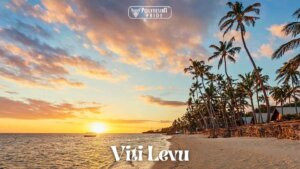 Viti Levu Island, Fiji
Viti Levu Island, Fiji
Viti Levu, Fiji’s largest island, spanning 10,388 square kilometers (4,011 square miles), serves as the nation’s political and economic center. Beyond the bustling capital city of Suva, Viti Levu offers a captivating blend of cultural immersion and thrilling adventures. Visitors can delve into Fijian culture at cultural centers, participate in a traditional kava ceremony, and explore vibrant handicraft markets. Adventure awaits with lush rainforests, hidden waterfalls, and renowned surf breaks. Popular tourist hotspots include the Coral Coast, famed for its beaches and coral reefs, and gateways to the Mamanuca and Yasawa Islands, known for luxurious resorts and water activities.
Vanua Levu: Untamed Beauty
 Vanua Levu Island
Vanua Levu Island
Vanua Levu, the second-largest island at 5,587 square kilometers (2,157 square miles), offers a more off-the-beaten-path experience. Escape the crowds and immerse yourself in untouched natural beauty and rich cultural heritage. Explore dense rainforests teeming with wildlife, kayak through mangrove channels, or brave white-water rafting adventures. Authentic Fijian villages offer cultural encounters, showcasing local crafts, cuisine, and warm hospitality. Divers will find paradise in the crystal-clear waters, especially at the renowned Rainbow Reef, a UNESCO World Heritage Site.
Taveuni: The Garden Isle
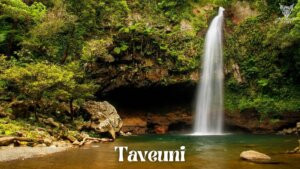 Unveil the Enchanting Lower Tavoro Waterfalls in Bouma National Park, Taveuni
Unveil the Enchanting Lower Tavoro Waterfalls in Bouma National Park, Taveuni
Taveuni, nicknamed the “Garden Island of Fiji,” is the third-largest, covering around 434 square kilometers (168 square miles), and is a haven for nature lovers. Lush rainforests, cascading waterfalls like Bouma and Tavoro Falls, and volcanic landscapes await exploration. Bouma National Heritage Park, a UNESCO World Heritage Site, offers hiking trails to breathtaking waterfalls and diverse flora and fauna. Taveuni is a leader in eco-tourism, offering eco-lodges, organic dining, and opportunities to support local conservation efforts.
Conclusion: Fiji’s Irresistible Location
In conclusion, Fiji’s location in the heart of the South Pacific, within the Melanesian subregion, is central to its identity as a tropical paradise. If you’ve been asking “Where Is Fiji Located?”, you now know it’s a jewel in the vast South Pacific Ocean. With Viti Levu as its largest island and a tapestry of smaller islands surrounding it, Fiji offers a diverse range of experiences, from adventure to relaxation. Its location ensures a warm tropical climate, stunning natural beauty, and a unique cultural heritage. So, with the question of location answered, why not start planning your Fijian adventure today and experience this South Pacific paradise firsthand?
FAQs
Where is Fiji Island in which country?
Fiji is not located in another country; it is a country itself. Officially known as the Republic of Fiji, it is an independent island nation situated in Melanesia, a subregion of Oceania in the South Pacific Ocean. It is positioned approximately 1,100 nautical miles (2,000 kilometers; 1,300 miles) north-northeast of New Zealand.
Is Fiji Island near Hawaii?
Fiji is situated in the South Pacific Ocean, while Hawaii is in the North Pacific. Fiji is located roughly two-thirds of the way from Hawaii towards New Zealand. While both are Pacific island destinations, they are geographically separated by a significant distance. Fiji’s closer neighbors include Vanuatu, Tonga, and Samoa in the South Pacific.
Is Fiji in Asia or Australia?
Fiji is considered part of the continent of Australia, which is also frequently referred to as Oceania. Oceania is the broader term encompassing the islands scattered throughout the Pacific Ocean that are not traditionally included in the seven-continent model. Therefore, while geographically closer to Australia than Asia, Fiji is part of Oceania/Australia.
What language do Fiji people speak?
The most widely spoken language in Fiji is Fijian. This Austronesian language, belonging to the Malayo-Polynesian family, has been present on the islands for over 3,500 years and is the official language. However, English and Hindi are also official languages of Fiji and are commonly spoken, reflecting the nation’s multicultural makeup.
